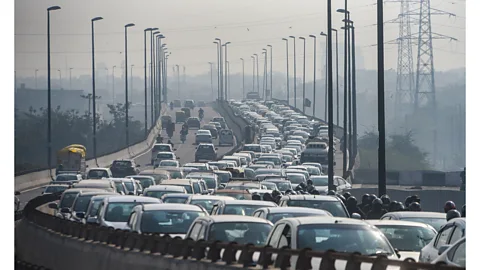What if all roads went underground?
 Zhuang Wang/Getty
Zhuang Wang/GettyRoads pollute cities, eat up public space and fragment habitats. Could moving them underground help?
In 1863, in an effort to reduce street traffic, London opened the world’s first underground line, the Metropolitan Railway. Its birth can be traced back two decades before to the building of the world’s first under-river tunnel below the Thames, which swiftly became both popular with pedestrians and a huge tourist attraction.
Initially, what would become the London Underground consisted of tracks dug slightly below the surface and then covered over. But as the technology improved, and trains switched from steam-powered to electric, the lines went deeper. Now the ground beneath Londoners’ feet hums with an extensive network of Tube lines ferrying people about the city speedily, efficiently – and out of sight.
There’s a huge appeal to putting infrastructure underground, says Bradley Garrett, a cultural geographer at University College Dublin and author of Subterranean London. "Human beings tend to like those things to be operating in the background." It gives the illusion of seamlessness, he says. "There's almost something magical about it."
Along with trains, powerlines, pipes, cables and sewers, there’s another piece of infrastructure some have long wished to bury – roads.
To some, these thick asphalt ribbons criss-crossing countries, paving over green space and cleaving apart communities and ecosystems no longer seem fit for purpose. As they sprawl longer and wider in the hopes of speeding up clotted traffic, congestion ticks upwards and cars continue to pollute the air and spew greenhouse gases.
There are more than 64 million km (40 million miles) of roads globally and large increases are predicted, especially in developing countries, as the world's population grows and incomes rise, meaning more people can afford cars. It is projected that there will be two billion cars on the road by 2040, with total traffic levels increasing by more than 50%.
Gridlocked traffic is not only a huge time suck – the average American driver wastes around 54 hours each year sitting in traffic – but it has an environmental toll, increasing fuel consumption, carbon emissions, and air and noise pollution.
"Traffic is soul destroying, it's like acid on the soul," Tesla founder Elon Musk said back in 2018 at an event for his tunnelling firm, the Boring Company. "Finally there's something, something that I think can solve the goddamn traffic problem." His answer: dig his way to better roads by putting them underground.
No one, not even Musk, has suggested burying every single one of the world's roads. But what would happen if we did relocate them all below the surface? In a time of increasing urbanisation, soaring inequality and climate crisis, imagining the impact this could have raises important questions about how our global transport system is developing – and prompts us to consider where we really want it to go.
 Hindustan Times/Getty
Hindustan Times/GettyOne of the most immediate impacts of a world without surface roads would be a huge freeing up of space across the globe.
In rural areas this could mean more land for farming or for rewilding, to help boost wildlife and pull carbon from the air. It would also mitigate one of the huge problems with roads: they fragment landscapes.
For animals, roads can act as a barrier, separating species from each other or from their prey. The global expansion of road networks threatens all apex predator conservation efforts, according to one recent paper, including by reducing their genetic connectivity and increasing poaching, with sloth bears and tigers the most at risk. Increased fragmentation is also leading to more carbon emissions, as it increases the amount of forest edges, where there is higher tree mortality.
Roads can also interrupt the flow of water, says Alisa Coffin, a research ecologist at the US Department of Agriculture. She points to the Tamiami Trail, a road connecting Tampa and Miami which has had disastrous effects for the Everglades by blocking water flow, leading to an increase in wildfires and impacting plants and animals. "It's an example of how a road was built without really understanding what the impacts would be," Coffin says.
You might also like:
Collisions between animals and cars are another big problem. Sarah Perkins, a Cardiff University lecturer, coordinates Project Splatter, a decade-old citizen science research project which monitors wildlife killed on UK roads. It receives about 10,000 reports of dead animals every year she says, but Perkins believes that’s a fraction of the real total. Some studies have put roadkill numbers at hundreds of millions a year in Europe alone.
Putting roads underground "could lead to less wildlife-vehicle collisions", Perkins says – provided the animals didn't use the tunnels. It would also remove light and noise pollution, which can affect animal behaviour around roads, she adds.
Despite these huge ecological impacts of getting rid of roads, however, it would be in cities, which are predicted to hold 70% of the global population by 2050, where the newly freed-up space would have the biggest impact on people.
"Can you imagine how the cities will be transformed">window._taboola = window._taboola || []; _taboola.push({ mode: 'alternating-thumbnails-a', container: 'taboola-below-article', placement: 'Below Article', target_type: 'mix' });
